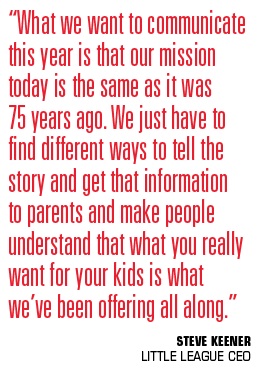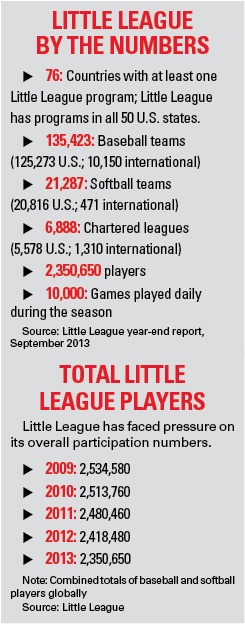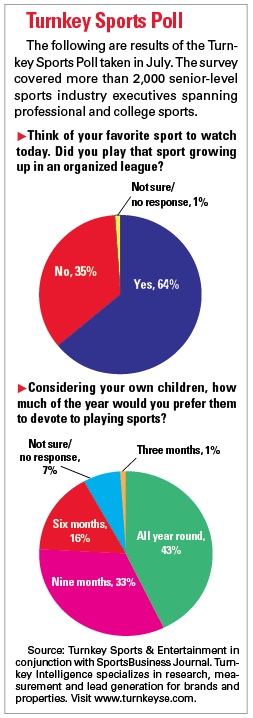At the red brick museum that preserves the history of Little League, each visitor’s trip begins as the organization did, in the backyard of Carl Stotz, a 29-year-old lumber store clerk who, as the story goes, hatched the idea for well-tended, child-sized ballfields after tripping on a lilac bush while playing with his nephews in his backyard.
Here, amid 10,000 square feet of artifacts and interactive exhibits, is the first home plate, which Stotz carved from a hunk of black rubber. An original base, sewn by his sister. The scribbling that became the first set of rules. Minutes from the earliest league meetings.
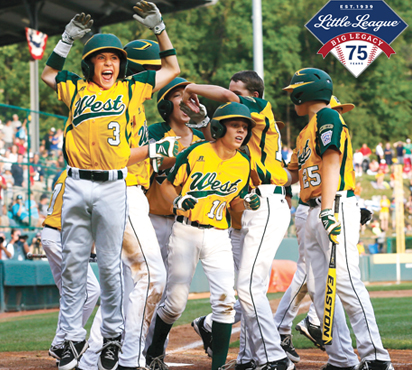 |
On the eve of the Little League World Series, the organization faces the challenge of staying pure to its mission in the increasingly competitive world of youth sports.
Photo by: Getty Images |
That Stotz founded Little League is evident. That he later argued that it shutter its marquee event, the Little League World Series, because he worried it had veered from his original intent is never mentioned.
There is a dichotomy to the world’s largest, best-funded youth sports organization, with about 2.4 million players on 160,000 teams across 76 countries, about 1.9 million of them in more than 5,500 leagues in the U.S.
{podcast}
SBJ Podcast:
Senior writer Bill King and Assistant Managing Editor Mark Mensheha, who both have backgrounds coaching youth sports, discuss Little League Baseball, the pressures it's facing and how youth sports have changed and continue to change.
At its core, Little League is as pure as it was the day it was founded 75 years ago, a member service-driven nonprofit that provides organization, insurance and other benefits to community leagues operated solely by volunteers, guided by the principle that any child who wants to play will find a safe and structured place, regardless of ability.
On its fringes, it is increasingly commercial, funded in large part by an eight-year, $76 million deal with ESPN, accented by about $4 million annually from national sponsors such as Honda, which touts its family-friendly vehicles as the preferred way to transport players to practices and games, and All laundry detergent, which is angling to be the choice to remove grass stains from 2 million pairs of white pants.
Little League organizers have balanced the two for decades, going back to 1953, when the World Series championship game first was telecast from Williamsport, Pa., with play-by-play provided by Jim McKay.
But the discussion has taken a turn in recent years. There still is debate about whether wall-to-wall exposure across ESPN’s platforms is developmentally appropriate for 11- and 12-year-olds. But now there is this additional wrinkle: A generation of parents who increasingly are asking for more than a fun and safe place for their children to pitch, hit and field.
For them, the youth sports fields aren’t so much a destination as a path.
Instructors selling hitting and pitching lessons. Travel team operators promising exposure to college recruiters and
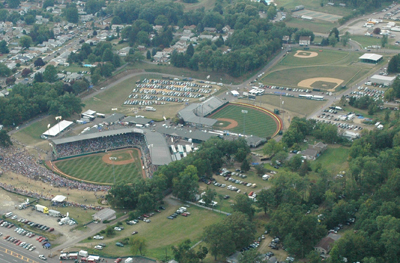 |
The sprawling home base of Little League in Williamsport, Pa., will come alive this month with the Little League Baseball World Series.
Photo by: Little League |
scouts. Coaches in other sports who explain, rather somberly, that their child can’t hope to reach the “next level” unless they make a year-round commitment to soccer or lacrosse or tennis. All of them are in parents’ ears and on their screens, positioning their services in ways that make the concept of a practice run by dads and moms and neighbors seem dated.
In a recent conversation in his office at Little League headquarters, down the parking lot from the museum, Little League CEO Steve Keener thoughtfully explored a range of issues — from the ESPN rights deal to travel teams to safety to training and beyond — all of them hitched to the broader question of whether a volunteer-based organization can remain relevant in today’s youth sports culture while staying true to principles laid down in the same year that Lou Gehrig played his final game.
This year, Little League is using its 75th anniversary as a platform to highlight the role it plays for children, regardless of whether they continue to play baseball competitively once they’ve aged out. Titled “Little League, Big Legacy,” the anniversary campaign includes the tag line: “Developing Major League People For 75 years.”
It was taken, Keener said, from the words of the founder of the Harlem Little League, former Citibank vice president Dwight Raiford, who long ago told him that the league’s goal was to “develop big league people, not big league players.”
“What we want to communicate this year is that our mission today is the same as it was 75 years ago,” said Keener, who has worked at Little League for 34 years and headed it for the last 20. “We just have to find different ways to tell the story and get that information to parents and make people understand that what you really want for your kids is what we’ve been offering all along.
“We have something here that still resonates and resonates strongly.”
In 2011, Little League launched a research study aimed at getting to the bottom of a decline in participation.
Through surveys and focus groups, it examined not only the preferences and behavior of children, but of parents.
What it found will not surprise you if you’ve spent any time around kids or youth sports of late. Today’s parents don’t want to spend three hours at a Little League field. They want their children not only to be active in a sport, but to be engaged by it.
And, because they grew up at a time when there were other sports to play and more organizations in which to play them, they aren’t necessarily familiar with Little League’s structure and its divisions.
Largely because of those findings, Little League has changed rather radically in the last few years, at least in the way it presents itself and interacts with its members.
It has turned its website into a vast resource both for league administrators who now have at their disposal tools to help with administration and fundraising, as well as for coaches, who often become coaches by accident, showing up for a volunteer meeting out of curiosity and leaving it with an equipment bag and a bucket of balls.
“Parents want what we’re offering,” Keener said. “They just don’t know where to find it. They want their kids to have an experience that is fun. That they get some exercise and feel like they’re a part of something special. They’re really not worried about that next level, for the most part. Some are. But, for the vast majority, what parents want is what we offer.”
Balancing act
There is so much to adore here, at the center of the youth baseball world. So much to stir the soul, including a setting in the Pennsylvania hills so spectacular that even terminally cool former major leaguers pause to soak it in.
Did you know you can’t buy a ticket to the Little League World Series? Admission is free. Fans file in through
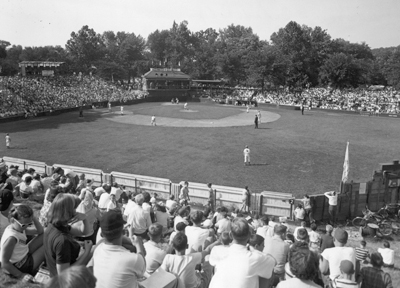 |
Much has changed, and much has stayed the same, since this photo was taken in Williamsport in 1942.
Photo by: Little League |
metal detectors, then make their way to either Lamade Stadium, which seats about 7,000 and can hold upward of 40,000 when fans pack the surrounding, two-tiered berm, or the adjacent Volunteer Stadium, which holds another 5,000.
Ask Pat Wilson, Little League’s senior vice president of operations and coordinator of all its tournaments, how much revenue the organization forgoes by letting fans in for free at an event that attracts upward of 400,000 a year and he shrugs his shoulders. The charter that governs Little League members across the country prohibits them from charging admission, Wilson points out.
“Not only is keeping it free here the nice thing to do,” he said, “but if we don’t allow our local leagues to sell tickets I don’t see how we can.”
Sponsorship is the fuel of any local Little League. It also plays a prominent role here. Little League has deals with 18 national sponsors, who together pay about $4 million annually for an association not just with the World Series, but with the body that is in contact with registered families in leagues nationwide (see story).
While the Little League World Series has a Fan Zone loaded with interactive areas operated by its sponsors, the outfield wall remains a clean green. When ESPN suggested it could create ad inventory with digital signs that would be seen on television but not in the stadium, Little League said no.
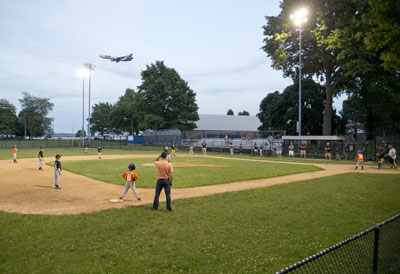 |
Little League sticks to the mantra that playing should be fun and not about trying to reach the “next level.”
Photo by: Getty Images |
“We’re all brand stewards here,” said Liz DiLullo Brown, Little League’s vice president of marketing and strategic partnerships. “You work here for just a little bit of time and you get it. You get that there’s a balance in what’s too commercial. Sometimes it’s us just talking it out. Here’s what the sponsor wants to do. We want to work with them.
But is it too far? How do we get to the families? Is it fun for the kids? Is it too far? We ask ourselves that question a lot.”
Keener tells the story of a sponsor that wanted to buy placement in “Building Blocks,” an in-game feature that over the years has had former major leaguers such as Harold Reynolds, Bobby Valentine and Nomar Garciaparra working with Little Leaguers, offering tips on how they might improve.
ESPN sold sponsorship of the feature to a company that wanted the players to wear shirts bearing their brand, rather than their Little League jerseys. When Keener balked at the idea, the sponsor pulled out.
“They lost the deal, but they agreed with us,” Keener said. “The line where we have to be careful is the commercial exploitation of children. We’re not going to do that.”
Yet Little League is no different from other properties in understanding that its bread is buttered by ESPN, which
delivers both a rights fee that will account for about a quarter of the organization’s annual revenue and exposure in front of about 70 million viewers each August.
Not only does the network air every game, it has brought its “SportsCenter” and “Baseball Tonight” shows to Williamsport.
“They allow us to tell our story,” said Wilson, the Little League executive who manages the relationship with ESPN. “Our friends at ESPN have a certain way they like to tell stories. They want access because they’re storytellers. But they can’t tell the story as if these kids were professionals, or even college athletes. We’ve developed a relationship where they respect our boundaries. We have no hesitation about saying no.
“But they allow us to tell our story in a way that — look, no other youth sports organization has this kind of platform, right? We all understand the opportunity we have here.”
Leaning over a set of blueprints spread across a table in his office, Little League CFO Dave Houseknecht ran a finger along an area behind the grandstands of Lamade Stadium, starting near home plate and stretching down the left-field line.
“We used to scrunch them in right here, right next to the stadium,” Houseknecht said, describing the challenge of fitting the satellite trucks, production trailers, sets and support stations that ESPN brings to Williamsport for two weeks each August. “It took up an incredible chunk of our property. We kept a two-car path so two vehicles could pass. But that was it.
“They outgrew what we could provide. They knew it and we knew it. It was just a question of finding a solution.”
That solution came during rights talks over the last few years. Little League knew it wanted to remain with ESPN, which provides a platform that dwarfs those of other youth sports programs.
Beginning this year, ESPN will have its own, self-contained compound in a paved area with easy access to both stadiums. There’s room for all the trucks and trailers, as well as an area for catering. Little League will pay for the project, which cost about $1.3 million, funding it through proceeds of the new rights deal.
That rights deal also will throw off benefits to local leagues. Shortly after it signed the agreement, Little League’s board of directors voted to lower its charter fees from $16 per team to $13 per team. It also created a distressed league fund of $500,000 and agreed to provide funding assistance for domestic and regional tournament hosts and stipends for World Series umpires in all divisions.
“We said we have to find a way to take that money and direct it back to the local programs,” Keener said. “We’re not like Major League Baseball or the NFL or NBA, where the money is going into the owners’ bank account.
We’re a nonprofit organization. We have an obligation to make sure we take those rights fees and redirect them back into the best services we can provide to our programs.”
A hesitant evolution
On a back field at the Williamsport complex, clusters of 9- to 12-year-olds are gathered in groups, going through the daily routine of sleepover baseball camp.
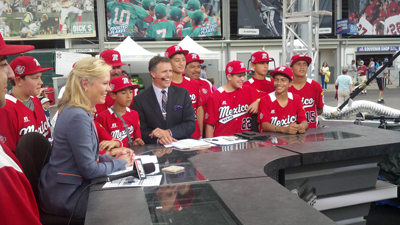 |
ESPN delivers major exposure to Little League and about a quarter of the organization’s annual revenue. It has brought its “SportsCenter” and “Baseball Tonight” shows to Williamsport.
Photo by: Little League |
On this morning, five weeks before the opening of this year’s World Series, representatives from Spalding are visiting. They’ve brought a baseball that they say is revolutionary, made of a polyurethane cover with raised seams that are not stitched. Spalding says it sheds water, resists scuffing and can last through a full season of play.
The company, which is in its fourth year providing Little League’s official ball, already is marketing it for use in practice. Now, they hope Little League will certify it for use in regular-season games. So they brought it to Williamsport, to be tested by the staff and the campers.
“We’re looking at it as we do any product,” Wilson said, “which is with a healthy skepticism. We’ll take a look at it and we’ll see.”
The complex offers an idyllic setting for camp. Along with the World Series stadiums and the practice complex, there is the Grove, an adjacent, gated area that the 16 teams stay in during the series, which includes living areas, a dining hall, a rec room and a pool.
About 1,000 campers come through the program each summer. In 2012, it generated $458,346 in revenue.
Each Thursday of camp, another of Little League’s sponsors is on hand to provide a perk that’s reflective of the evolving manner in which players and their parents view youth sports. The Baseball Factory was founded 20 years ago as a recruiting and placement service for high school players. Over time, it began offering more services geared toward not only exposing players to college programs, but improving their skills. It now is one of the top such providers in the country, with more than 375 alumni playing in the major leagues.
Five years ago, Little League hired the Baseball Factory to help create its online coaches resource center, which now includes more than 100 videos and primers that offer ideas on teaching skills and running practices.
Last year, Baseball Factory revamped the Little League division that probably needed the most help, creating a week-by-week tee-ball curriculum that endeavors to teach the game in a structure that’s age appropriate and fun.
Each Thursday of camp, staff from the Baseball Factory put players through a scout-styled workout, which they record. They then evaluate each player and provide a report that lets them know where they stand compared to others their age, offering suggestions on ways they can improve.
“We’re among the largest at what we do and we work with 35,000 [high school] players a year,” said Jason Budden, senior vice president of marketing and brand for the Baseball Factory. “Little League gives us access to millions of players that we’re able to introduce ourselves to at an even younger age.”
While Little League’s mission is geared toward benefiting all children, the marketing relationship with the Baseball Factory and other recent moves by Little League are in response to the subset within its membership that demands more, and has shown it will take its bats, balls and players elsewhere if it doesn’t get it.
Keener is no fan of travel baseball, speaking out against the practice strongly and frequently, largely because much that Little League has done to make the game safer for children — most notably, adopting strict pitch counts — can be negated by an irresponsible travel team coach.
And yet, he concedes that some of the teams that you see in Williamsport are, in fact, travel teams that play in other tournaments to prep for the road to Williamsport. He’s also not crazy about year-round baseball, invoking the name of former big league player and current Little League manager Mike Mussina when he advises families to encourage their children to play multiple sports. And yet Little League sanctions fall baseball, which is popular in the moderate climates that frequently produce the most competitive teams.
 |
A youth participates in a summer training camp in Williamsport.
Photo by: Little League |
Keener explains that leagues were going to offer a program in the fall with Little League or without it, so he’d prefer they be subject to the same oversight as they are in the traditional season.
“We offer it because we can’t stop it,” Keener said. “We can’t make it go away. So we have to live with it and manage it.”
That’s the same reason Little League recently added its intermediate division, with larger field dimensions and rules closer to those used in high school. If it didn’t, the leagues that wanted those dimensions simply would have dropped their Little League charters and moved on to another organization that offered the bigger field, such as Ripken Baseball.
This is, after all, a membership-based organization. Rather than feuding with leagues and revoking charters, as the administration has previously, Little League has moved more toward making its case directly to parents on its website and through a newsletter that reaches more than 1 million readers.
“We have what parents want,” Keener said. “Maybe they’ve changed in some ways. But we all still want what we think is best for our kids.”
Celebrating the anniversary
Here’s a sampling of elements planned around Little League’s 75th anniversary:
■ The anniversary is being shared via social media under the official hashtag: #LittleLeague75.
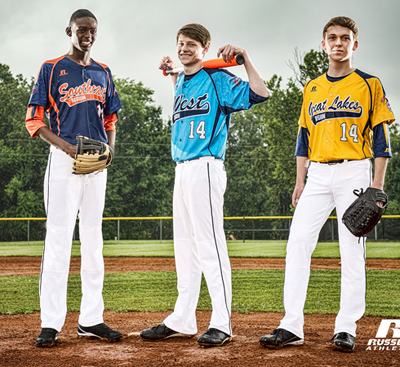 |
Russell designed these uniforms for the Little League World Series.
Photo by: Russell / Little League |
■ Major League Baseball teams are holding Little League days throughout the season. MLB honored the anniversary during July’s All-Star Game in Minneapolis.
■ The Little League Big Legacy Project is a unique, digital baseball mosaic with images supplied by the public and spanning 75 years of Little League memories. Check it out at: LittleLeagueBigLegacy.com.
■ ESPN has produced short-form retrospectives that will feature some of the most significant moments and important people in Little League history. The vignette series is airing this summer.
■ VIA Studios Global, a division of WVIA Public Media, created “Little League: The History,” an original documentary film.
■ Pop artist Charles Fazzino worked with fifth-grade students from Pennsylvania schools to create a one-of-a-kind work of art that will be unveiled at this year’s Little League Baseball World Series.
■ The Little League Baseball World Series will feature many special guests and Little League alums.
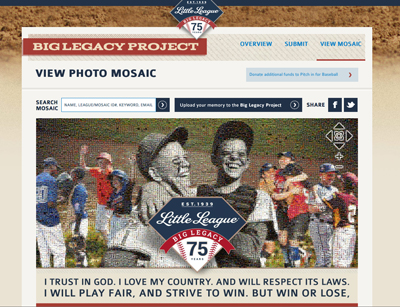 |
A photo mosaic captured memories.
|
■ Russell Athletic and Little League unveiled new uniform combinations for this year’s Little League Baseball World Series, designed specifically to celebrate Little League’s anniversary.
■ LittleLeagueBigLegacy.com provides information on the history of Little League, an interactive timeline, photos and videos, and up-to-date information on events and activities.




